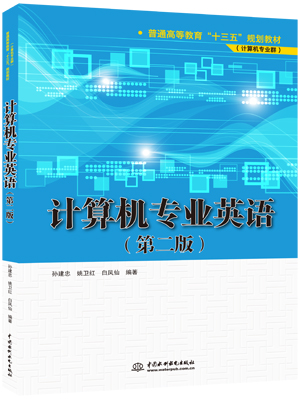计算机专业英语(第二版)

-
【作 者】孙建忠 姚卫红 白凤仙
【I S B N 】978-7-5170-7233-1
【责任编辑】张玉玲
【适用读者群】本专通用
【出版时间】2018-12-28
【开 本】16
【装帧信息】平装(光膜)
【版 次】1-2
【页 数】272
【千字数】443
【印 张】17
【定 价】¥42
【丛 书】普通高等教育“十三五”规划教材(计算机专业群)
【备注信息】
简介
本书特色
前言
章节列表
精彩阅读
下载资源
相关图书
本书以计算机技术和网络技术为背景,精选了14个主题:计算机的历史与发展、微型计算机的结构、数制与布尔代数、数据结构、操作系统、软件工程、编程语言、Internet、WWW、计算机与网络安全、大数据、多媒体技术、物联网和云计算等,并力求体现计算机技术与应用的最新发展。
本书所选材料语言规范、内容新颖、完整实用。每章除包括学习指导、课文、注释、译文、阅读材料和练习之外,还精选了14个专业英语学习专题,介绍专业词汇及其构成规律、科技英语的阅读与翻译技巧、科技论文的写作和阅读技巧、求职英语和广告英语的要点等。
本书是计算机专业的专业英语教材,也可作为广大科技工作者使用计算机的参考书。
第二版前言
随着计算机网络技术的飞速发展,人类已经进入了信息时代。世界似乎在悄悄地变小,中外经济、文化、科技交往日趋频繁,而这一切都是以语言为载体的。由于诸多原因,国际上最通用的语言还是英语,而因特网的普及更巩固了英语作为跨文化交往通用语言的地位。因此,为了掌握最新的计算机技术、了解计算机的发展动向,必须具备较高的英语水平。
本书的编写目的,首先是让学生掌握计算机专业英语的基本术语,了解一些计算机专业的基本知识;其次是让学生掌握专业英语的阅读、翻译和写作技巧,提高专业技能;此外,还介绍了计算机技术的一些最新发展。
本书以计算机与网络技术为背景,精心组织、合理选材,主要内容包括计算机的历史与发展、微型计算机的结构、数制与布尔代数、数据结构、操作系统、软件工程、编程语言、Internet、WWW、计算机与网络安全、大数据、多媒体技术、物联网和云计算等。考虑到提高学生专业技能的需要,我们还系统而扼要地介绍了计算机词汇及其构成规律、科技英语的阅读与翻译技巧、科技论文的阅读、翻译和写作技巧,以及求职英语和广告英语等专业英语的学习要点。
本书由大连理工大学的孙建忠、姚卫红、白凤仙编写,具体分工为:白凤仙编写第1章至第4章,姚卫红编写第5、6、7、10、12章,孙建忠编写第8、9、11、13、14章和专业英语专题,并负责全书统稿工作。
由于作者水平有限,书中难免出现疏漏,恳请读者批评指正。
编 者
2018年10月
第二版前言
第一版前言
Chapter 1 The History and Future of
Computers 1
本章学习指导 1
1.1 The Invention of the Computer 1
1.2 Computer Generations 2
1.3 Near-future Supercomputer Directions 6
Reading Material: Classes of Computing
Applications and Their Characteristics 7
科技英语的特点 9
Exercises 11
Chapter 2 Organization of Computers 12
本章学习指导 12
2.1 Basic Organization of Computers 12
2.2 CPU Organization 16
2.3 Memory Subsystem Organization
and Interfacing 18
2.4 I/O Subsystem Organization and
Interfacing 23
Reading Material:Eight Great Ideas in
Computer Architecture 25
计算机英语专业词汇的构成 27
Exercises 31
Chapter 3 Number Systems and
Boolean Algebra 32
本章学习指导 32
3.1 Number Systems 32
3.2 Boolean Algebra 37
Reading Material: Moore’s Law 39
数学公式的读法(Pronunciation of
mathematical expressions) 41
Exercises 43
Chapter 4 Data Structure 44
本章学习指导 44
4.1 An Introduction to Data Structures 44
4.2 Stacks 45
4.3 Queues 47
常用英汉互译技巧 49
Exercises 53
Chapter 5 Operating System 55
本章学习指导 55
5.1 OS Function 55
5.2 Evolution of OS Function 58
5.3 OS Structure 59
被动语态的翻译技巧 63
Exercises 65
Chapter 6 Software Engineering 66
本章学习指导 66
6.1 The Software Life Cycle 66
6.2 Design Methodologies 71
Reading Material: Software Security 73
复杂定语(从句)的翻译技巧之一 77
Exercises 80
Chapter 7 Programming Languages 81
本章学习指导 81
7.1 Computer Languages 81
7.2 Object-Oriented Programming 82
Readinging Material: OMG’s Unified
Modeling Language(UML) 89
复杂定语(从句)的翻译技巧之二 91
Exercises 93
Chapter 8 The Internet 95
本章学习指导 95
8.1 The Internet: Technology Background 95
8.2 The Internet Today 103
8.3 Internet II: The Future Infrastructure 109
Reading Material: Researcher Develops
Colorful Map of the Internet 112
英语长句的翻译 113
Exercises 117
Chapter 9 The World Wide Web 118
本章学习指导 118
9.1 Hypertext 118
9.2 Markup Languages 119
9.3 Web Servers and Clients 121
9.4 Web Browsers 122
Reading Material: The Internet and
The Web: Features 123
学术论文的英文写作简介 127
Exercise 130
Chapter 10 Computer and Network Security 131
本章学习指导 131
10.1 Characteristics of Computer Intrusion
and Kinds of Security Breaches 131
10.2 Modern Cryptography- Data Encryption 133
10.3 How Firewalls Work 136
科技论文标题的写法 139
Exercises 141
Chapter 11 Big Data 142
本章学习指导 142
11.1 What Is Big Data? 142
11.2 Cross-Disciplinary Approach, New
Skills, and Investment 145
11.3 Acquiring Relevant Data 146
11.4 The Basics of How Big Data
Technology Works 146
Reading Material: The Impact of Big
Data on Discovery 147
英文摘要的写作技巧 148
Exercises 152
Chapter 12 Multimedia 154
12.1 Multimedia 154
12.2 Elements of Multimedia 156
12.3 Introduction to Computer Graphics 158
12.4 Computer Animation 161
Reading Material: an Introduction to and
History of Virtual Reality 163
英文论文引言的写作技巧 165
Exercises 171
Chapter 13 Anatomy of the Internet of
Things 172
学习指导 172
13.1 Traditional Internet Protocols Aren’t the
Solution for Much of the IoT 173
13.2 It’s All Relative 177
13.3 Applying Network Intelligence at
Propagator Nodes 180
Reading Material: Machine learning: what
and why? 186
求职英语简介 186
Exercises 189
Chapter 14 Cloud Computing 191
学习指导 191
14.1 Definitions 191
14.2 Related Technologies for Cloud
Computing 193
14.3 Cloud Service Models 196
14.4 Cloud Deployment Models 197
14.5 Public Cloud Platforms: State-of-the-Art 198
14.6 Business Benefits of Cloud Computing 200
Reading Materials: Advanced technologies in
cloud computing 201
广告文体简介 202
Exercise 204
参考译文 205
第1章 计算机的历史与未来 205
第2章 计算机的组成 208
第3章 数制与布尔代数 214
第4章 数据结构 218
第5章 操作系统 220
第6章 软件工程 225
第7章 程序设计语言 228
第8章 因特网 231
第9章 万维网 239
第10章 计算机与网络安全 242
第11章 大数据 246
第12章 多媒体 250
第13章 物联网的剖析 254
第14章 云计算 260
参考文献 266
- 零基础玩转国产大模型DeepSeek [徐永冰 张帅 编著]
- 网络工程师5天修炼(适配第6版考纲) [主编 朱小平 施游]
- 信息系统项目管理师考试32小时通关(适用第4版考纲) [薛大龙]
- 信息系统管理工程师考试32小时通关(适配第2版考纲) [薛大龙 刘伟]
- 土木工程材料检测实训 [洪晓江 达则晓丽 钱波]
- 科技信息检索与论文写作实用教程 [李振华]
- 传统山水画论解读与实践 [陈钠 著]
- Python数据库编程 [主编 殷树友 邢 翀]
- 计算机基础实训指导 [主编 袁春萍 朱妮]
- 嵌入式人工智能技术应用(数字教材) [主编 胡娜 杨国勇 晏廷荣]
- Vienna整流器技术 [桂存兵 著]
- 变频器与伺服应用 [陈刚 叶云飞]
- 物联网工程设计与实践 [汤琳 李敏]
- 炉边夜话——深入浅出话AI [汪建 著]
- 电商运营与管理 [钟肖英 陈潇]
- Java面向对象程序设计 [主编 姜春磊 陈虹洁]
- 信息技术基础(Windows 10+WPS Office)(微课版) [主编 石利平 田辉平 谢盛嘉]
- 人工智能应用 [主编 陈 萍 刘培培 陈孟军]
- 大学生职业发展与就业指导 [主编 刘志坚]
- 高级办公应用项目教程 [主编 屈晶 赵成丽]
- 微信小程序开发项目实战(微课版) [主编 黄龙泉 郭峰 朱倩]
- 企业档案工作实战宝典百问百答 [华俊 卢秀英 邵甜甜 著]
- 计算机网络原理及应用 [主编 唐继勇 叶坤 孙梦娜]
- 大学生创业基础 [主编 王丽莉 王 杨]
- 船舶辅机 [主编 王连海 于洋 姜淑翠]
- 大学生就业指导 [主编 王丽莉 董宴廷]
- 系统架构设计师章节习题与考点特训 [主编 薛大龙 邹月平]
- 高校学生工作探索与实践 [郭亮 著]
- 大学生情商管理 [方雄 著]
- 2023年长沙市会展业发展报告 [主编 周栋良]

